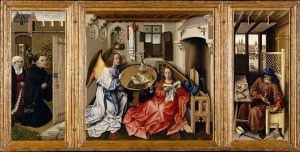30 January 2024
We were treated to two inspiring talks from Steven Galvin LRPS: The first on Panels and Triptychs; the second on HDR in a post-HDR world.
Steven is a Freelance Photographer, a member of Marlow Camera Club, a Judge and a member of the RPS Thames Valley Region.
Steven began is talk by reviewing the history and definitions of Panels, Triptychs and Portfolios. A portfolio is simply defined as any set of images with a common author.
Historically a triptych was a painting (usually religious) made up of three sections. They were traditionally made of two ‘wings’ or ‘shutters’ attached to either side of a central panel. Sometimes the panels were hinged so that the wings can be closed to protect the images for storage or transportation.
A panel is a group of images (can be more than three) with a well defined theme. We were shown some examples during Jo Teasdale’s talk (www.joteasdalephotography.com/conceptual-gallery).
For Panels and Triptychs Steven stressed the importance of the connection between them “the whole is greater than the sum of the parts”. For presentations he encouraged creativity, but that there should be synergy between the chosen aspect ratios, light and colours of the panel or triptych. This is not to say they should be the same, but that the reason for any difference fits the narrative of the panel / triptych. He also stressed that if there was an horizon in all of the images, it should be in the same position in each image. Finally, when submitting images for display, then there should be an order specified by the author.
Steven then showed us a variety of panels and triptychs, demonstrating where they “didn’t work”, before sharing some examples that did.
For the second talk, Steven demonstrated how to use HDR in a constructive way to compliment different photographic workflows, including some of the software applications available to process HDR images, along with some of their Pros and Cons.
For Multiple Image HDR, Steven stressed the point of using a good tripod to hold the camera still whilst taking images at a variety of exposures (perfect “goldilocks”, -1, -2, +1, +2 stops). Many modern cameras have an in built “bracketing”, but it is entirely possible to do manually. Steven also reminded the audience to check their images in the field, so that more could be taken if there were any issues with the set taken. Once having the set of exposures then it is a case of checking for areas where there may be “ghosting”; where there is movement between the images. Steven demonstrated the key differences between some of the major applications, particularly the ability to refine the merge, especially where ghosting could be an issue.
Where a tripod isn’t available, Steven then discussed how to create Hand held HDR sets. Here his recommendation was to take lots of sets of images, so that one can select the best versions from the different sets, for HDR blending.
Finally, Steven covered Single Image HDR (sometimes referred to as “Extended Range”). This is a workflow that requires a RAW image file, as it contains all of the information available at the point of capture. In a RAW editor one can boost the shadows and reduce the highlights to recover information otherwise lost in them.
Steven finally showed us an image taken inside York Cathedral, where he had both stacked the shots (changed focal point from front to back) and bracketed them. The result was a single, perfectly sharp image from front to back, giving all of the details within the cathedral and of the stain glass windows.
A thoroughly enjoyable evening was had by all, and lots to think about going forward.
Examples of Steven’s work can be found here:
Website: stevengalvin.photography
Facebook: www.facebook.com/StevenGalvin.Photography
Instagram: www.instagram.com/stevengalvin.photography

